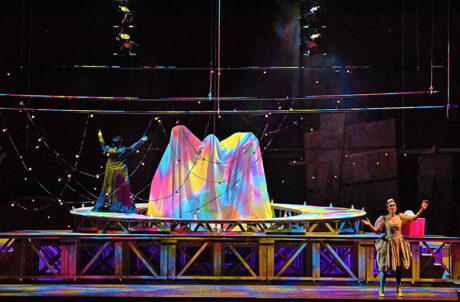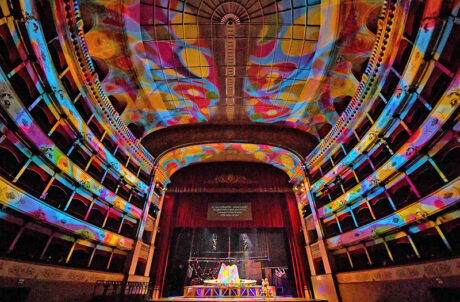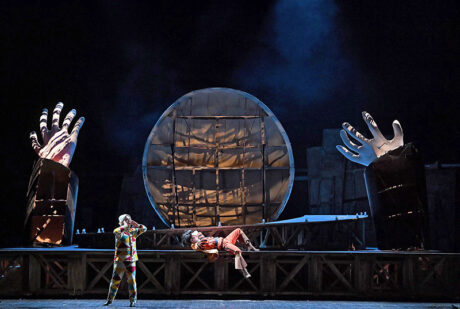
The recent production of Le Maschere (The Masks), an opera by Pietro Mascagni written as an homage to Rossini and the Italian opera buffa and commedia dell’arte traditions, at the Fondazione Teatro Goldoni in Livorno, Italy proved a huge success.

The production was lit by lighting designer and chief electrician at the Goldoni, Michele Rombolini who, since his youth, has been amazed by the ability to change emotions through the different uses of light, and fascinated by its power of artistic expression. “This was the first time I have actually used Ayrton lights, although I have been lucky enough to see these fixtures on a few occasions in the last two years at some of the theatres I work with,” says Rombolini. “The first thing that struck me about the Ayrton fixtures was the quality of the light and color.”

Both are important considerations to Rombolini, as he explains, “When my staff and I thought to renovate our lighting system, we divided our priorities into amount of light needed and the quality of the light itself. So we allocated part of the available budget to the quality of the light and the ‘purity’ of the color, which is a fundamental characteristic for the opera performances we develop in our theatre.” This need for an LED fixture that offered a high color quality while maintaining an excellent light output, along with a precise framing system, led Rombolini to Ayrton’s TC version of the Eurus Profile as the best combination of all of these qualities.

For Le Maschere, Rombolini rigged five Eurus Profiles on the front truss, three of which were mainly responsible for focusing precisely on the 10m x 9m rotating platform that occupied the main part of the stage. The other two Eurus sited at each end of the truss were used for both sharp shutter cuts and specials. During the proscenium scenes that took place in front of the curtain, the three central Eurus Profile TCs were used to shape a backlight on the proscenium. Two further Eurus Profiles were positioned on the second truss and mainly used as specials and as a continuation of those covering the stage revolve.

Three Eurus Profiles were used as backlighting and four more were rigged on the third and fourth upstage trusses in the ‘cut position,’ working on the theatre’s large proscenium providing front light from acute side angles. These units were the ones called upon to perform the most difficult task because the cut position and resulting angles are often prohibitive, yet the Eurus managed to perform it perfectly. Four Ayrton Diablo S profiles were also utilized, placed above a 3m high truss, to highlight the chorus at certain moments, or to form corridors of light within which the singers performed. During the closing of Act I, Rombolini used four Eurus to define a clear path along the entire length of the proscenium where the singers entered and exited according to the dictates of the director. “The performance of the optical system and the framing shutter was excellent, making that cut of light as dramatic as we wanted,” he comments.

The director’s choice was to use all available stage space without the use of black backdrops or wings in order to emphasize the scenic structures, the back wall and the stage walls. This created the sense as if one were inside a warehouse where the protagonist masks were being built for a carnival float. Some moments of the opera took place with the curtain closed, making full use of the wide proscenium. Classic party scenes that were brightly lit and playful, contrasted with other scenes with a deliberately ‘darker’ and isolated visual impact; others characterized by the important and almost menacing presence of gobos or perfectly focused shutter cuts, sharp as knives, changed to scenes with a rock-style lighting, full of chases of movement and saturated with color.

“We managed to characterize some scenes precisely thanks to the use of Eurus and its gobos,” notes Rombolini, “for example, by using the prismatic Tree Bark gobo and Animation Wheel, we created a moonlit sea effect. Another scene in which the use of gobos took center stage was the characterization that we wanted to bring in for the moment of presentation of Harlequin’s mask; in this case we had a series of poles and other scenic elements in view and we used Eurus’s prismatic multicolored CMY liquid effect gobos that reminded us of Harlequin’s dress, which we then projected across the whole auditorium and the scenic elements present. We made further use of gobos through the projection of a stylized skyline on the back wall using two Eurus and gobos from among the many that the Eurus fixtures offer. Certainly the colors obtained with Eurus and their uniformity is one of the first points I had noticed, and that the fixtures themselves confirmed during this production,” Rombolini adds. “I used and greatly appreciated the light frost, very soft, gradual and excellent for giving that touch of blur when using the frame system of the fixture.”
For more information on Ayrton Eurus Profile and the full range of Ayrton LED and laser-sourced lighting fixtures, visit www.ayrton.eu


